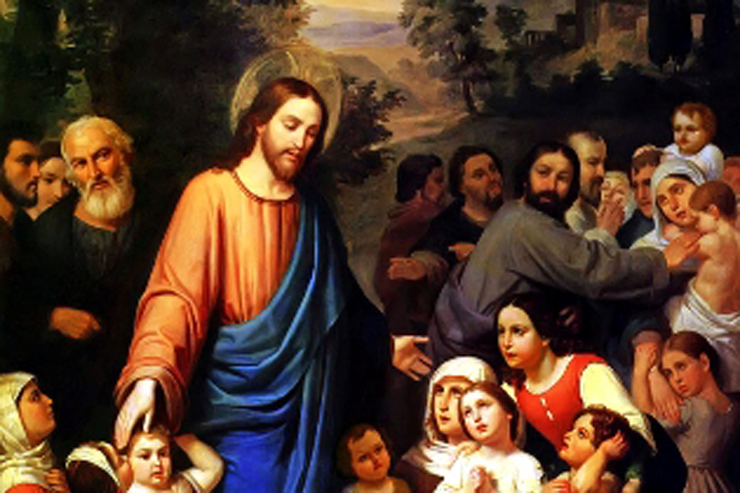
Wedding Rings
The challenge to the Defense of Marriage Act (DOMA) argued before the U.S. Supreme Court last week was about a complaint by a woman who was not able to get a federal marriage estate tax exemption when her partner died and had to pay taxes on more than a $363,000 inheritance. They had married in Canada in 2007, where the institution had been redefined. Although their home state of New York had not then redefined marriage, they had a law recognizing what other jurisdictions had called marriage. She filed a lawsuit claiming DOMA, which defines marriage as only between a man and a woman, discriminated against her by treating her differently than other married people.
William B. May author of the booklet, Getting the Marriage Conversation Right: a Guide for Effective Dialogue, and President of Catholics for the Common Good (CCG) uses this example to help people understand that the marriage issue today is not about participation of same-sex couples in marriage. In order for her to win her case, she is asking that marriage between a man and a woman be taken out of the law.
“Redefining marriage is a two-sided coin,” he explains. “On one side, finding laws defining marriage between a man and a woman unconstitutional may permit same-sex couples to marry, but since marriage between a man and a woman forms the only civil institution geared to unite kids with their moms and dads, it would consequentially make promoting the unique value of men and woman marrying before having children also unconstitutional for the same reason as Ms. Windsor’s DOMA complaint. To do so, would imply that a marriage that unites not only a man and a woman with each other but with any children born from their union would have a higher value and reveal that the “marriages” of same-sex couples are different.
May wonders if this is an unintended consequence of redefining marriage or if it is more of a hidden agenda. He quotes Yale law professor William Eskridge’s statement that redefining marriage “involves the reconfiguration of the family, deemphasizing blood, gender, and kinship ties.”
Traditional Marriage Unconstitutional?
“Finding the definition of marriage in DOMA unconstitutional could create tremendous confusion as federal marriage tax benefits could be conveyed to same-sex couples in states where marriage is redefined, but what happens when they move to a state where marriage has been protected in the constitution?” May asks. “However, it is important to not get to distracted by focusing on marriage as merely as vehicle for conveying benefits.” He reminds us that DOMA applies to all federal laws, policies and programs. “With the trend of the Department of Education trying use coercive efforts to influence local education curricula, how would finding the only civil institution that unites kids with their moms and dads unconstitutional combined with other anti-discrimination policies, try to change how marriage and family is presented in schools across the country?” he wonders.
“Cultural influences and misconceptions are confusing people with false premises,” May states. To help peel away the cultural influences that lead people into traps when defending traditional marriage, May’s booklet was written as part of training materials for a new movement for the promotion of marriage. He uses a technique in the booklet that he calls “reality-based thinking.” For example, he helps the reader discover and verify the reality of marriage, family, and alternative families by looking at these from the perspective of the child within us. “It takes humility to recognize what Christ taught us, ‘Father … although you have hidden these things from the wise and learned you have revealed them to the childlike.’(LK 10:21)”,
Soul-Mate Model
May’s booklet points out that there is a marriage crisis in which almost every family has been touched with adult children having children of their own outside of marriage. The booklet is not critical of men or women who find themselves in such situations, and acknowledges that single parenting and unstable relationships make raising children very difficult, as government data reflects.
The booklet points out that sociologists confirm that a large part of the problem is the meaning and purpose of marriage has changed in the minds of young people. Fewer and fewer are seeing marriage relevant to children and family. Bradley Wilcox from the University of Virginia described this new perception of marriage as the “soul-mate model,” — an institution purely adult centered for personal growth, emotional intimacy and based on the happiness of the parties. According to May, redefining marriage turns this model into law.
However, he says, “The one thing both liberal and conservative sociologists agree on is something must be done to reverse the current trend. The problem is that there is currently no organized constituency to support them, which demonstrates the need for the new marriage movement, Catholics for the Common Good and other like-minded people are beginning to organize.”
Currently, more than half of children born to women under 30 are outside of marriage. The breakdown of marriage is directly related to the increase number of children living in poverty as well as the devastating human and social consequences of the increasing incidence of fatherlessness. What concerns almost every sociologist and family policy expert most, May says, is that this phenomenon that was once common only to the least educated and poor, is rapidly moving into Middle America with staggering social and economic consequences. “Ironically, while the redefinition of marriage is being forced on society by judicial fiat in many cases and misrepresentations of the real consequences, nearly all sociologists seem to agree that to reverse the decline of marriage we need social marketing programs similar to those that changed attitudes and behavior on smoking, the environment, drinking and driving, seat belts, and now obesity. Such programs are needed to change this understanding of marriage and promote men and women marrying before having children,” May says.
He points out that programs to promote marriage would not only address a very serious social problem, but would also recognize the fundamental human right of children to know, and as far as possible, be raised in a family with their mothers and fathers united in marriage, as the Catholic Church happens to teach. “Mothers and fathers today are viewed as merely biological artifacts, when in fact, if we turn to our own experience, our mothers and fathers are all part of our identity,” he says. “We yearn for these connections and to be loved by them, even in cases of alienation or the loss of one or both parents through death or divorce.”
However, May points out, “If the only institution that unites kids with their moms and dads is found unconstitutional and therefore illegal for the Federal government to promote, it will make the goal of reversing the trend of births to single women and fatherlessness impossible to achieve. “How will children learn the importance of marrying before having children if schools and institutions are required to present marriage as a purely adult centric institution?” he asks. “To avoid a discriminatory bias, alternative families with children deprived of married mothers and fathers must be presented as a positive role models that children can aspire to when they become adults.”“Teaching children, whether in schools or through the popular culture, that marriage is an adult centric institution with no connection to children and family should be of concern to every family,” May says. “What parent wants their grandchildren to be deprived of a mom and dad united in marriage? Who wants their child to grow up to be a single parent?”
The booklet, Getting the Marriage Conversation Right: a Guide for Effective Dialogue, helps cut through the confusion surrounding the marriage issue and get to the heart of the issue which ultimately is what is best for children. Thus far, that point seems to be missing from the conversation.
Patti Maguire Armstrong and her husband have ten children. She is a writer with Teresa Tomeo Communications, an award-winning author, and was managing editor and co-author of Ascension Press’s Amazing Grace Series. She has appeared on TV and radio stations across the country. Her latest books, Big Hearted: Inspiring Stories from Everyday Families, and children’s book, Dear God, I Don’t Get It (available for pre-order now!) will both be released in April.
To read more, visit Patti’s blog and website. Visit her author page on facebook and also GPS Guide to Heaven and Earth, Homeschool Heart and Big Hearted Families.
Looking for a Catholic Speaker? Check out Patti’s speaker page and the rest of the ICL Speaker’s Bureau.
Please post your comments and questions below. We value your feedback.
If you appreciate our writing, please use both the Share and Recommend buttons to tell your family and friends about this article. Help us help others live the faith throughout their day.
Thank you! – The Editors













